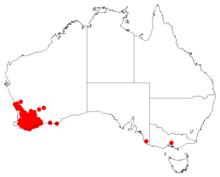Isopogon teretifolius Taxonomy References Navigation menu"Isopogon teretifolius""On the Proteaceae of Jussieu""Kuntze, Otto (1843–1907)"On the Cultivation of the Plants Belonging to the Natural Order of ProteeaeThe Paradisus LondinensisRevisio generum plantarum:vascularium omnium atque cellularium multarum secundum leges nomenclaturae internationales cum enumeratione plantarum exoticarum in itinere mundi collectarum"Congrès international de Botanique de Vienne"10141422387123808403660568447704604-1894940kew-2867581ISTE4urn:lsid:ipni.org:names:704604-1100398441expanding iteexpanding iteexpanding ite
Eudicots of Western AustraliaIsopogonPlants described in 1810Endemic flora of Western AustraliaProteaceae stubsWestern Australian plant stubsAustralian eudicot stubs
ProteaceaeWestern AustraliaRobert BrownOtto KuntzeRichard Salisburynomenclaturally conservedInternational Botanical Congress
| Nodding coneflower | |
|---|---|
 | |
Scientific classification | |
| Kingdom: | Plantae |
Clade: | Angiosperms |
Clade: | Eudicots |
| Order: | Proteales |
| Family: | Proteaceae |
| Genus: | Isopogon |
| Species: | I. teretifolius |
Binomial name | |
Isopogon teretifolius R.Br. | |
 | |
| Occurrence data from Australasian Virtual Herbarium | |
Synonyms | |
Atylus teretifolius (R.Br.) Kuntze | |
Isopogon teretifolius, commonly known as the nodding coneflower, is a small shrub of the family Proteaceae that is endemic to the southwest of Western Australia.[1]
Taxonomy
Isopogon teretifolius was first described by Robert Brown in 1810.[2] In 1891, German botanist Otto Kuntze published Revisio generum plantarum, his response to what he perceived as a lack of method in existing nomenclatural practice.[3] Because Isopogon was based on Isopogon anemonifolius,[4] and that species had already been placed by Richard Salisbury in the segregate genus Atylus in 1807,[5] Kuntze revived the latter genus on the grounds of priority, and made the new combination Atylus teretifolius for this species.[6] However, Kuntze's revisionary program was not accepted by the majority of botanists.[3] Ultimately, the genus Isopogon was nomenclaturally conserved over Atylus by the International Botanical Congress of 1905.[7]
References
^ "Isopogon teretifolius". FloraBase. Western Australian Government Department of Parks and Wildlife..mw-parser-output cite.citationfont-style:inherit.mw-parser-output .citation qquotes:"""""""'""'".mw-parser-output .citation .cs1-lock-free abackground:url("//upload.wikimedia.org/wikipedia/commons/thumb/6/65/Lock-green.svg/9px-Lock-green.svg.png")no-repeat;background-position:right .1em center.mw-parser-output .citation .cs1-lock-limited a,.mw-parser-output .citation .cs1-lock-registration abackground:url("//upload.wikimedia.org/wikipedia/commons/thumb/d/d6/Lock-gray-alt-2.svg/9px-Lock-gray-alt-2.svg.png")no-repeat;background-position:right .1em center.mw-parser-output .citation .cs1-lock-subscription abackground:url("//upload.wikimedia.org/wikipedia/commons/thumb/a/aa/Lock-red-alt-2.svg/9px-Lock-red-alt-2.svg.png")no-repeat;background-position:right .1em center.mw-parser-output .cs1-subscription,.mw-parser-output .cs1-registrationcolor:#555.mw-parser-output .cs1-subscription span,.mw-parser-output .cs1-registration spanborder-bottom:1px dotted;cursor:help.mw-parser-output .cs1-ws-icon abackground:url("//upload.wikimedia.org/wikipedia/commons/thumb/4/4c/Wikisource-logo.svg/12px-Wikisource-logo.svg.png")no-repeat;background-position:right .1em center.mw-parser-output code.cs1-codecolor:inherit;background:inherit;border:inherit;padding:inherit.mw-parser-output .cs1-hidden-errordisplay:none;font-size:100%.mw-parser-output .cs1-visible-errorfont-size:100%.mw-parser-output .cs1-maintdisplay:none;color:#33aa33;margin-left:0.3em.mw-parser-output .cs1-subscription,.mw-parser-output .cs1-registration,.mw-parser-output .cs1-formatfont-size:95%.mw-parser-output .cs1-kern-left,.mw-parser-output .cs1-kern-wl-leftpadding-left:0.2em.mw-parser-output .cs1-kern-right,.mw-parser-output .cs1-kern-wl-rightpadding-right:0.2em
^ Brown, Robert (1810). "On the Proteaceae of Jussieu". Transactions of the Linnean Society. 10: 71.
^ ab Erickson, Robert F. "Kuntze, Otto (1843–1907)". Botanicus.org. Retrieved 28 November 2015.
^ Knight, Joseph (1809). On the Cultivation of the Plants Belonging to the Natural Order of Proteeae. London, United Kingdom: W. Savage. p. 94.
^ Hooker, William (1805). The Paradisus Londinensis. 1. London, United Kingdom: D. N. Shury.
^ Kuntze, Otto (1891). Revisio generum plantarum:vascularium omnium atque cellularium multarum secundum leges nomenclaturae internationales cum enumeratione plantarum exoticarum in itinere mundi collectarum. Leipzig, Germany: A. Felix. p. 578.
^ "Congrès international de Botanique de Vienne". Bulletin de la Société botanique de France. 52: LIII. 1905.
This Proteaceae-related article is a stub. You can help Wikipedia by expanding it. |
This Western Australian plant article is a stub. You can help Wikipedia by expanding it. |
This Australian eudicot article is a stub. You can help Wikipedia by expanding it. |
Australian eudicot stubs, Endemic flora of Western Australia, Eudicots of Western Australia, Isopogon, Plants described in 1810, Proteaceae stubs, Western Australian plant stubsUncategorized